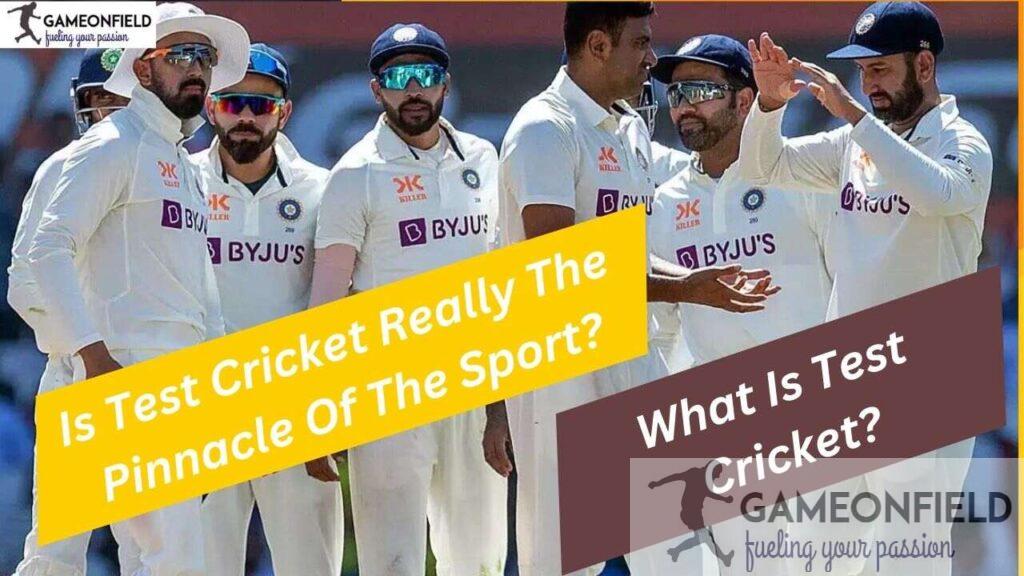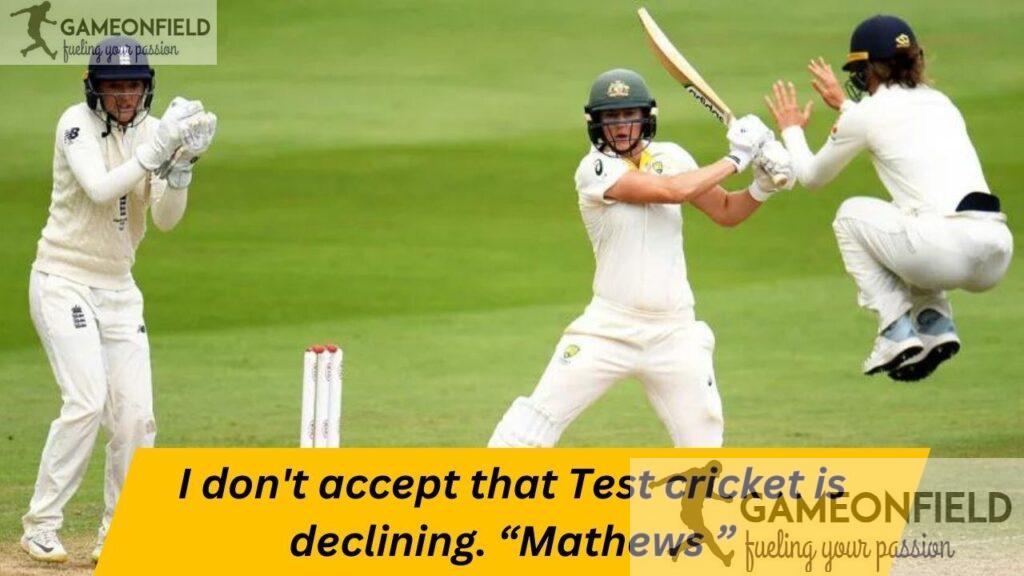Test cricket, the oldest and most revered form of cricket, tests a player’s ability, character, and stamina. It showcases the great qualities of the game and offers a unique challenge that other cricket modes cannot match. This blog post explores the intricacies of Test cricket, including its rich history, various formats, and current understanding of the world of cricket.
Test cricket is a five-day tournament with four innings. The match was played between two teams that are fully part of the International Cricket Council (ICC). Each team must play two innings in a contest. For example, if a test match is played between two teams (Team A and Team B), then Team A and Team B would have to play two innings each. A team can win only if they chase the number of runs or eliminate the other team by the end of the fifth day.

The Origins and Evolution of Test Cricket
The first officially recognized Test match in the history of test cricket was played in 1877 between Australia and England at the Melbourne Cricket Ground (MCG). The history of international cricket as we know it began. Test cricket has changed over time, maintaining its originality while adapting to the changing nature of the game.
- Early Days: The early years of Test matches were marked by premature struggles that lasted until the final. But as the game progressed, the idea of a five-day tournament was added to balance competitive excitement with real-world issues.
- The rivalry between England and Australia: The Ashes match between England and Australia is one of the most famous matches in Test cricket. Since its inception in 1882, the tournament has produced some of the most incredible stories in cricket history.
What Formats of Test Matches are Played
Test cricket is typically played in the following formats:
- Traditional Five-Day Tests: The most popular format, in which two teams play for five days, each batting twice (called an innings). The objective is to score more runs than the opposition, and if the entire innings is not completed within the allotted time, the outcome of the game could be a draw.
- Day-Night Tests: Day-night Tests with pink balls under lights instead of the traditional red balls have been added to improve the game’s spectator friendly Test cricket new from this system, especially in countries with high daytime temperatures It can be more.
- Timeless Tests: Timeout Tests Was common in the early 20th century when games were played until a result, regardless of the number of days needed, is rare in current cricket. Due to logistical difficulties, this program was abandoned.
- Four-Day Tests: A recent effort sought to make Test cricket more appealing to a wider audience. The four-day trials have been tried, but reactions from players and spectators have varied, with some believing the integrity of the system could be in jeopardy.
Check Out: What Is A Mentor?
What is the main purpose of Playing Test Cricket?
Test cricket is regarded as the pinnacle of cricket testing, and it differs from other formats in a few special ways.
- Using Different Tactics: The expansion of the game tests players’ endurance—mentally and physically. It requires calculated planning, with timing and planning largely deciding the outcome of the competition.
- Achieving Success: Winning in Test cricket is considered a badge of honor. Through incredible performances, legendary cricketers like Sir Don Bradman, Sachin Tendulkar, and Sir Vivian Richards have cemented their place in Test cricket history.
- Adapting the New Changes in Environment: Test cricket has changed to reflect the times with the introduction of pink-dirty tests and Decision Reference Systems (DRS) to maintain the structure of these changes has been fun and current for new fans.
Ground Parameters
Pitch and Field
The 22-foot-long, 10-foot-wide cricket pitch is made of rolled grass or clay. It can have a dramatic effect on the field by changing how the ball behaves and how players approach the ball.
Boundary Dimensions
Normally, the boundary of a Test cricket pitch is 65–90 feet from the center of the pitch. Specific designs may vary depending on the venue but are intended to create a level playing field.
Rules of Test Cricket
Innings and Overs
For two innings, each team takes turns batting and bowling. The batting team will try to score as many runs as possible while the bowling team will try to remove the batting opposition from the game. In Tests, a team can bowl an unlimited number of overs. One over is six legitimate deliveries.
Dismissals and Follow-On
If ten of the twelve batsmen of a team are out, they are out. If the team batting second scores significantly fewer runs in their first innings than the team batting first, the reverse rule can be applied. If the captain of the first batting team decides to order a follow-up, the second batting team must immediately play again.
Umpiring and Decision Review System (DRS)
Calendar is important for Test matches with decisions about dismissals, boundary calls, and overall conduct. Teams can contest umpire decisions through the Decision Review System (DRS) which uses technology to monitor and possibly overturn fouls.
Clothing and Equipment
Traditional White Attire
As a tribute to the tradition the game was founded on, cricketers wear traditional white. This covers white shirts, pants, helmets, or hats. In addition to its historical significance, wearing white clothing reduces heat loss.
Protective Gear
Due to the fast pace and unpredictability of the game, players are equipped with protective equipment such as helmets, pads, gloves, and stomach protectors. Fielding positions also require protective gear, especially for near fielders who can be hit by powerful shots.
Players and Roles
Team Composition
The twelve players in the Test match team have different roles. They usually have a combination of bowlers, wicketkeepers, all-rounders, and batsmen. In addition to managing the team on the field, the captain is an important member of the leadership team.
Specialist Players
Cricketers sometimes devote their careers to specialized roles such as middle order or opening bowlers, fast bowlers, bowlers, or wicketkeepers, so that the specialists sleep the dynamics of the game have emerged and require specific skills and abilities for each task.
Is Test Cricket Really The Pinnacle Of The Sport?
In the interview, Mathews expressed his strong sentiment, stating, “Tests are the pinnacle of cricket.
“I don’t accept that Test cricket is declining. Most cricketers, including myself, love Test cricket, it’s the top organization. While T10, T20, and different associations offer extraordinary open doors, Test cricket stays the zenith for me. I would forfeit anything to play a Test match. The Test Title has imbued energy and style into cricket. It was by all accounts losing its allure, however, the WTC has renewed it with more tone, adherents, and fervor,” he said.

In What Ways Might Test Cricket Change In The Future?
Test cricket has a long history and great significance, however, in the present day it faces many difficulties:
- Commercial Success: The popularity of Twenty20 leagues and other limited-overs cricket has made it difficult for Test cricket to remain commercially successful Boards and broadcasters are constantly looking for ways to boost the format’s economy.
- Player work and schedule: The hectic nature of international cricket tournaments has raised questions about player fatigue and burnout. Cricket boards are trying to find a way to reconcile the requirements with other policies.
- Engagement and Viewership: The future of Test cricket depends on bringing in new fans and appealing to younger audiences. Day-night experimentation and creative distribution channels are examples of projects that represent good starting points.
Conclusion
Test cricket is a true test of one’s endurance, technique, and skill. Cricket fans around the world respect the format for its rich history, traditional format, and complex tactics. Everything about Test cricket, from the all-white uniforms to the strict rules, adds the usual charm.
